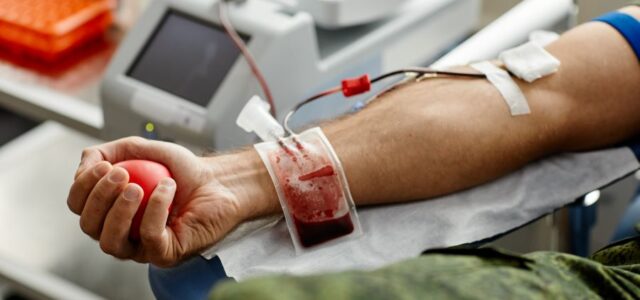
In their article “Transfusion-transmitted babesiosis in a patient with sickle cell disease undergoing chronic red cell exchange,” Costa and colleagues describe a patient who contracted Babesia from a donor living in Ohio, a state that is not considered endemic for Babesia.¹
According to the authors, a 30-year-old man with sickle cell disease (SCD) required approximately 10 units of red blood cells every 3–4 weeks throughout his childhood.
Approximately 2 months after a red blood cell exchange, he presented with fever, neck pain, and photophobia. Several days later, he developed a persistent fever, chills, headache, fatigue, and loss of appetite.
He was diagnosed with Babesia through identification of parasites in his red blood cells and positive antibodies. He was also borderline positive on an antibody test for Anaplasma phagocytophilum and Ehrlichia chaffeensis.
“Prior to laboratory-based blood donor screening for Babesia, transfusion-transmitted babesiosis (TTB) was a leading infectious risk to the blood supply in the United States.”
The young man was treated for Babesia with azithromycin and atovaquone for 10 days with resolution of his symptoms. He was not treated for Anaplasma phagocytophilum or Ehrlichia chaffeensis.
The patient lived in a state endemic for Babesia but did not recall a tick bite.
“A donor lookback investigation was initiated with the blood supplier,” the authors wrote. They found that in the preceding 6 months, the patient had received 65 units of blood, with 58 units screened for Babesia.
Unfortunately, “One of the donors of the 7 untested units was B. microti seropositive,” the authors wrote. The donor lived in a state not requiring Babesia screening.
“Our case demonstrates the continued vulnerability of the US blood supply to Babesia.”
“The seropositive donor had not had any symptoms of babesiosis; he lived in Ohio and reported being very active over the past year, including hiking and camping in several states (Ohio, Tennessee, and North Carolina),” the authors wrote.
In 2019, the FDA recommended testing of blood donors for Babesia in the 14 states where almost all cases of Babesia have been reported. “The policy confined to 14 states (Connecticut, Delaware, Maine, Maryland, Massachusetts, Minnesota, New Hampshire, New Jersey, New York, Pennsylvania, Rhode Island, Vermont, Virginia, Wisconsin),” wrote the authors.
Authors Conclude:
“Heightened awareness and health care provider education are imperative, especially in non-endemic [states] where clinicians may not be accustomed to diagnosing community-acquired or TTB, placing transfusion recipients at risk of delayed diagnosis and severe disease.”
Related Articles:
Prolonged Babesia infection in a patient with asplenia
Babesia and anaplasmosis in a child with B cell acute lymphoblastic leukemia
References:
- Costa V, Mercure-Corriveau N, Gourneau J, et al. Transfusion-transmitted babesiosis in a patient with sickle cell disease undergoing chronic red cell exchange. Transfusion. Jan 13 2023;doi:10.1111/trf.17244



This exact situation happened to me. I received 3 units of blood at UCLA in 1984 and came down with both Lyme Disease and Babesiosis. This happened back in 1984 and I was not diagnosed until I was 39 years of age. I have to be grateful that those were all I came down with as UCLA had HIV in their blood bank at the time (aka. Tom Hanks “And The Band Played On”). I have been successfully treated.
I have found treatment for Babesia can be helpful despite my patients being ill for years.
Yes! I did your treatment at the Envita Medical Center in Arizona. Spent 3 months with daily treatments. It worked. The procedures were excellent, the clinic itself not so much. Wish I had gone to Ottawa! All in all I am extremely grateful.
The government officials and Ohio State University know they have Babesia odocoilei in their blacklegged tick, Ixodes scapularis, in Ohio, but have concealed this research information. Then, the medical doctors don’t have to deal with it. I believe this practice is corrupt. Patients are left to suffer. Chronic human babesiosis caused by Babesia odocoilei is very hard to treat, if not impossible to treat.
I live in a small town in rural Pennsylvania, also small hospital. While I was in the waiting room of my primary care physician I overheard a couple about in their 60’s, mentioning something about Lyme to another person there. I chimed in and told the couple I had been fighting Lyme for about 15 yrs.
They then told me the husband contracted a tick borne disease (not Lyme) from a blood transfusion at our little hospital but they could not remember how to pronounce the name…I said “Babesiosis.
Yes! That was it. The husband was so ill of course they transferred him to a larger hospital for treatment and he was a patient for 4 weeks! He almost died. That was the first I have ever heard of that happening and I heard from the patient and his wife directly. I could hardly believe it. I’ve never read anything about that before either. Now this incident happened about 3 yrs ago. I do hope they are screening for Lyme and it’s coinvections. That was a terrifying experience for that man and his wife.
I wonder if babesia testing is still only required in a few states, 14 in 2023. The west coast has a different species of babesia and it can be missed even if testing is required in those states. People do not always get bitten by a tick in the state where they live.